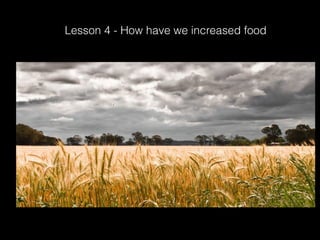Signaler
Partager
Télécharger pour lire hors ligne

Recommandé
Reflections on potential Introduction of wheat and sunflower for food security in South SudanReflections on potential Introduction of wheat and sunflower for food securit...

Reflections on potential Introduction of wheat and sunflower for food securit...Independent Science and Partnership Council of the CGIAR
Recommandé
Reflections on potential Introduction of wheat and sunflower for food security in South SudanReflections on potential Introduction of wheat and sunflower for food securit...

Reflections on potential Introduction of wheat and sunflower for food securit...Independent Science and Partnership Council of the CGIAR
Contenu connexe
Similaire à Lesson 4 how have we increased food
Similaire à Lesson 4 how have we increased food (20)
"Full Planet, Empty Plates: The New Geopolitics of Food Scarcity"

"Full Planet, Empty Plates: The New Geopolitics of Food Scarcity"
centres of origin-biodiversity and its significance.pptx

centres of origin-biodiversity and its significance.pptx
Wilhelm Gruissem - Global Plant Council: A coalition of plant and crop societ...

Wilhelm Gruissem - Global Plant Council: A coalition of plant and crop societ...
Food Production, Nutrition and Environmental Effects

Food Production, Nutrition and Environmental Effects
Plus de coburgpsych
Plus de coburgpsych (20)
Lesson 1 physiological and psychological charactertistics of responses to s...

Lesson 1 physiological and psychological charactertistics of responses to s...
Lesson 4 how have we increased food
- 1. Lesson 4 - How have we increased food
- 2. From last lesson Make a list of the main staple foods of the world and the places (continents) where they are grown. • Cereals: wheat, barley, rye, oats, maize, rice • Root vegetables: potatoes, yams, taro, cassava • Legumes: soya beans, sago • Fruits: breadfruit, plantains Cultivation! • Fish: coastal areas in developing countries • Wheat: across the world • Maize: throughout the Americas originally, then spread to the rest of the world, especially the United States
- 4. The Green Revolution refers to a series of research, and development, and technology transfer initiatives, occurring between the 1940s and the late 1960s, that increased agricultural production worldwide, particularly in the developing world, beginning most markedly in the late 1960s.